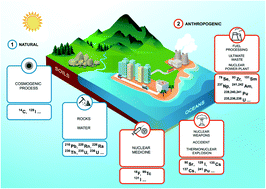Radionuclide analysis using collision–reaction cell ICP-MS technology: a review
Abstract
The analysis of radionuclides (RN) is of major concern in different fields like the environment, geosciences, the nuclear industry, and medical research. Inductively coupled plasma mass spectrometry (ICP-MS) is a valuable technique for rapid and highly sensitive analysis of RN in different types of samples. Incorporating collision–reaction cells (CRC) into ICP-MS instruments is a very attractive and elegant way to overcome spectral interferences, which affects the accuracy of measurements. This paper reviews the elemental and isotopic analysis of RN using CRC technology for different types of applications including environmental studies, the nuclear industry, forensics and biological applications. The various collision–reaction cell technologies implanted in the ICP-MS instruments, are described and discussed. The different strategies based on collision–reaction mechanisms for RN analysis described in the literature are detailed element by element, including actinides (U, Pu, Am, Cm and Np), fission products (Se, Sr, Mo, Zr, I, Cs, lanthanides) and a decay product of the uranium series (Ra).



 Please wait while we load your content...
Please wait while we load your content...